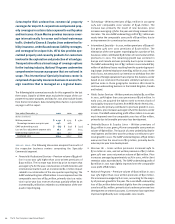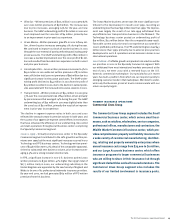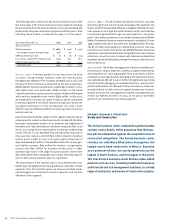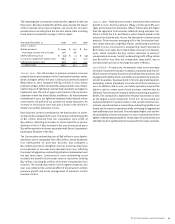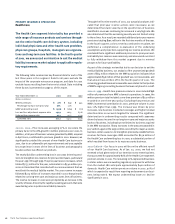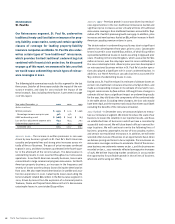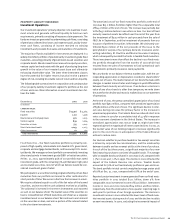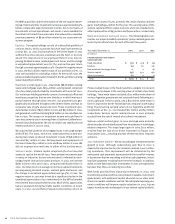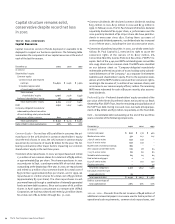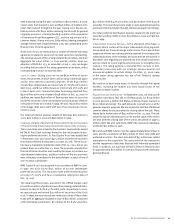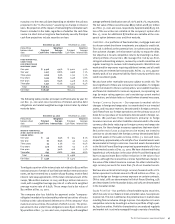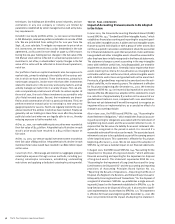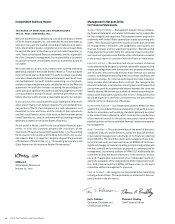Travelers 2001 Annual Report Download - page 33
Download and view the complete annual report
Please find page 33 of the 2001 Travelers annual report below. You can navigate through the pages in the report by either clicking on the pages listed below, or by using the keyword search tool below to find specific information within the annual report.
The St. Paul Companies 2001 Annual Report 31
property-liability underwriting
Loss and Loss Adjustment Expense Reserves
Our loss reserves reflect estimates of total losses and loss adjust-
ment expenses we will ultimately have to pay under insurance and
reinsurance policies. These include losses that have been reported
but not settled, and losses that have been incurred but not reported
to us (“IBNR”). Loss reserves for certain workers’ compensation
business and certain assumed reinsurance contracts are discounted
to present value. We reduce our loss reserves for estimates of
salvage and subrogation.
For reported losses, we establish reserves on a “case” basis within
the parameters of coverage provided in the insurance policy or rein-
surance agreement. For IBNR losses, we estimate reserves using
established actuarial methods. Our case and IBNR reserve esti-
mates consider such variables as past loss experience, changes in
legislative conditions, changes in judicial interpretation of legal lia-
bility and policy coverages, and inflation. We consider not only
monetary increases in the cost of what we insure, but also changes
in societal factors that influence jury verdicts and case law and, in
turn, claim costs.
Because many of the coverages we offer involve claims that may
not ultimately be settled for many years after they are incurred, sub-
jective judgments as to our ultimate exposure to losses are an
integral and necessary component of our loss reserving process.
We record our reserves by considering a range of estimates
bounded by a high and low point. Within that range, we record our
best estimate. We continually review our reserves, using a variety
of statistical and actuarial techniques to analyze current claim costs,
frequency and severity data, and prevailing economic, social and
legal factors. We adjust reserves established in prior years as loss
experience develops and new information becomes available.
Adjustments to previously estimated reserves are reflected in our
financial results in the periods in which they are made.
While our reported reserves make a reasonable provision for all of
our unpaid loss and loss adjustment expense obligations, it should
be noted that the process of estimating required reserves does, by
its very nature, involve uncertainty. The level of uncertainty can be
influenced by such things as the existence of coverages with long
duration payment patterns and changes in claim handling practices.
Many of the insurance subsidiaries within The St. Paul’s group have
written coverages with long duration payment patterns such as
medical professional liability, large deductible workers’ compensa-
tion and assumed reinsurance. In addition, claim handling practices
change and evolve over the years. For example, new initiatives are
commenced, claim offices are reorganized and relocated, claim
handling responsibilities of individual adjusters are changed, use
of a call center is increased, use of technology is increased, caseload
issues and case reserving practices are monitored more frequently,
etc. However, these are sources of uncertainty that we have
recognized in establishing our reserves.
Note 9 to the financial statements includes a reconciliation of our
beginning and ending loss and loss adjustment expense reserves
for each of the years 2001, 2000 and 1999. That reconciliation
shows that we recorded an increase in the loss provision from
continuing operations for claims incurred in prior years totaling
$577 million in 2001, compared with reductions in prior-year
incurred losses of $265 million and $208 million in 2000 and
1999, respectively.
The increase in prior-year loss provisions in 2001 was driven by
additional losses emerging in our Health Care segment. In 2000,
loss trends in this segment had indicated an increase in the sever-
ity of claims incurred in the 1995 through 1997 accident years;
accordingly, we recorded a provision for prior-year losses. In 2001,
loss activity continued to increase not only for the years 1995
through 1997, but also 1998, and early activity on claims incurred
in the years 1999 through 2001 indicated an increase in severity for
those years. Those developments led us to a much different view
of loss development in this segment, which in turn caused us to
record provisions for prior-year losses totaling $735 million in this
segment in 2001. At the end of the year, we announced our inten-
tion to withdraw fully from the medical liability insurance market.
A reduction in prior-year losses was recorded in 2000 and 1999. In
2000, the favorable prior-year loss development was widespread
across lines of business with the exception of the Health Care seg-
ment. In 1999, favorable prior-year loss development in several lines
of business, including workers’ compensation and assumed rein-
surance, was partially offset by adverse development in our Ocean
Marine operation and certain commercial business centers.
property-liability underwriting
Environmental and Asbestos Claims
We continue to receive claims alleging injury or damage from envi-
ronmental pollution or seeking payment for the cost to clean up
polluted sites. We also receive asbestos injury claims tendered
under general liability policies. The vast majority of these claims
arise from policies written many years ago. Significant legal issues,
primarily pertaining to the scope of coverage, complicate our
alleged liability for both environmental and asbestos claims. In our
opinion, court decisions in certain jurisdictions have tended to
broaden insurance coverage beyond the intent of original insurance
policies.
Our ultimate liability for environmental claims is difficult to estimate
because of these legal issues. Insured parties have submitted
claims for losses that in our view are not covered in their respective
insurance policies, and the final resolution of these claims may be
subject to lengthy litigation, making it difficult to estimate our
potential liability. In addition, variables such as the length of time
necessary to clean up a polluted site, and controversies surround-
ing the identity of the responsible party and the degree of
remediation deemed necessary, make it difficult to estimate the
total cost of an environmental claim.
Estimating our ultimate liability for asbestos claims is also very dif-
ficult. The primary factors influencing our estimate of the total cost
of these claims are case law and a history of prior claim develop-
ment, both of which are still developing.
The following table represents a reconciliation of total gross and
net environmental reserve development for each of the years in the
three-year period ended Dec. 31, 2001. Amounts in the “net” column
are reduced by reinsurance recoverables.



